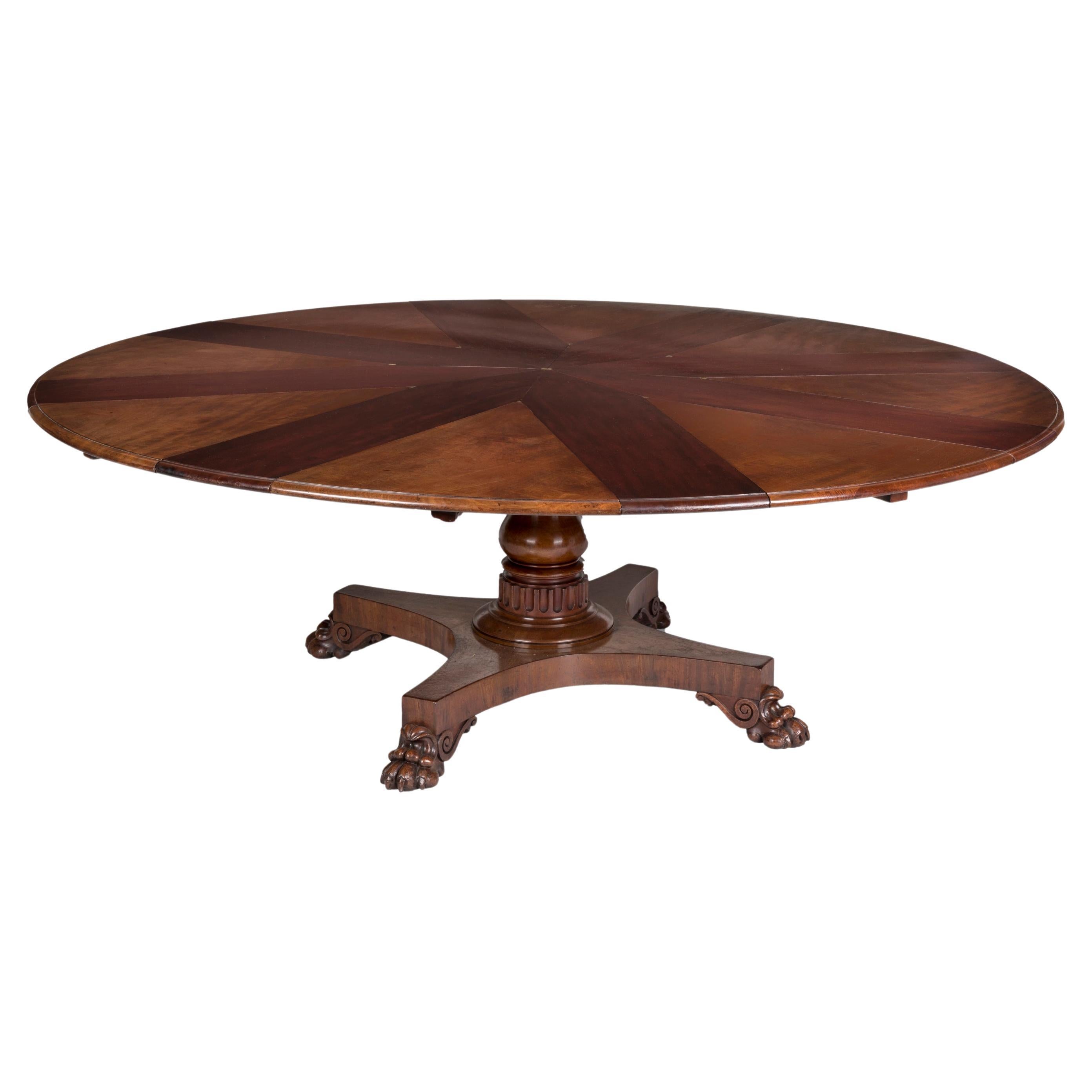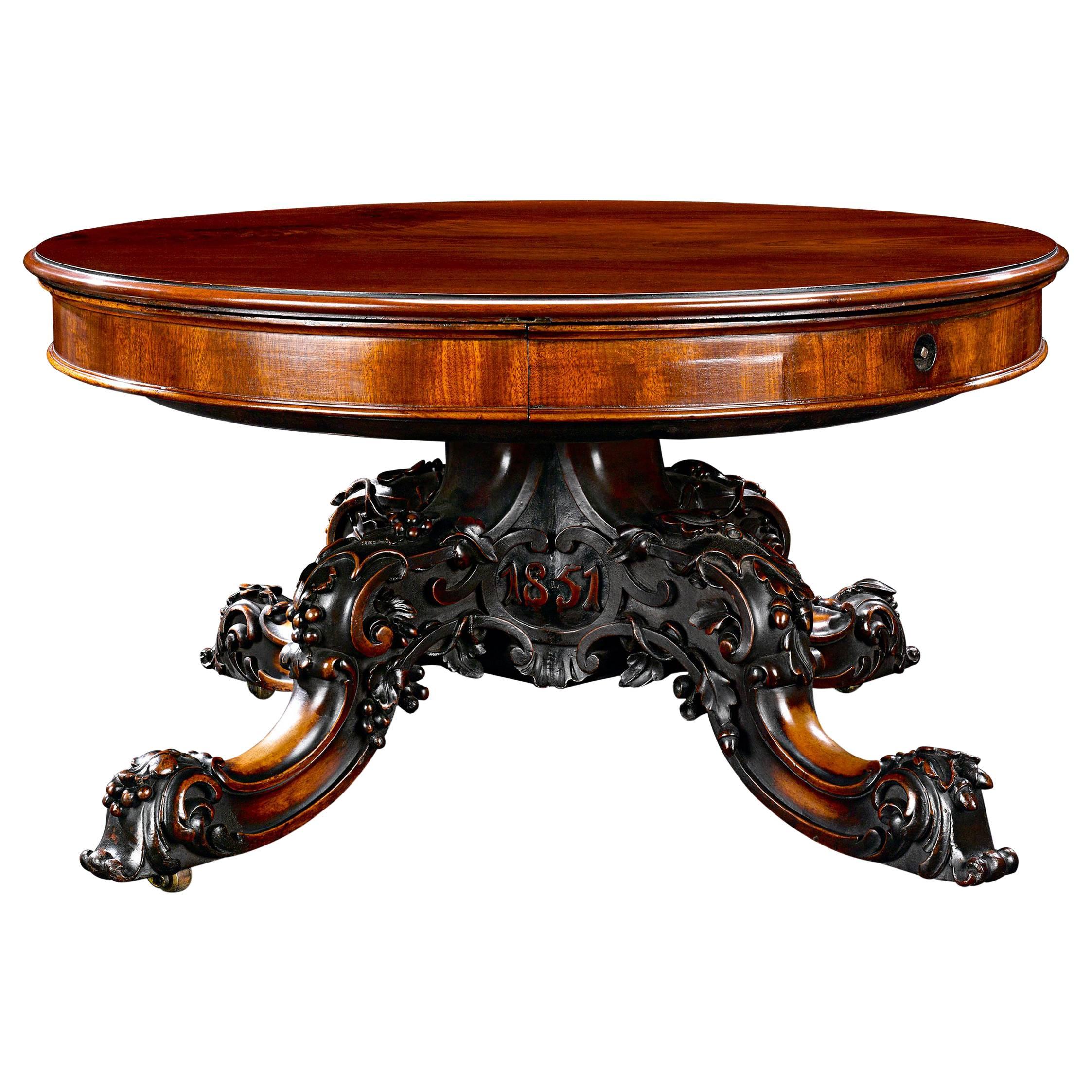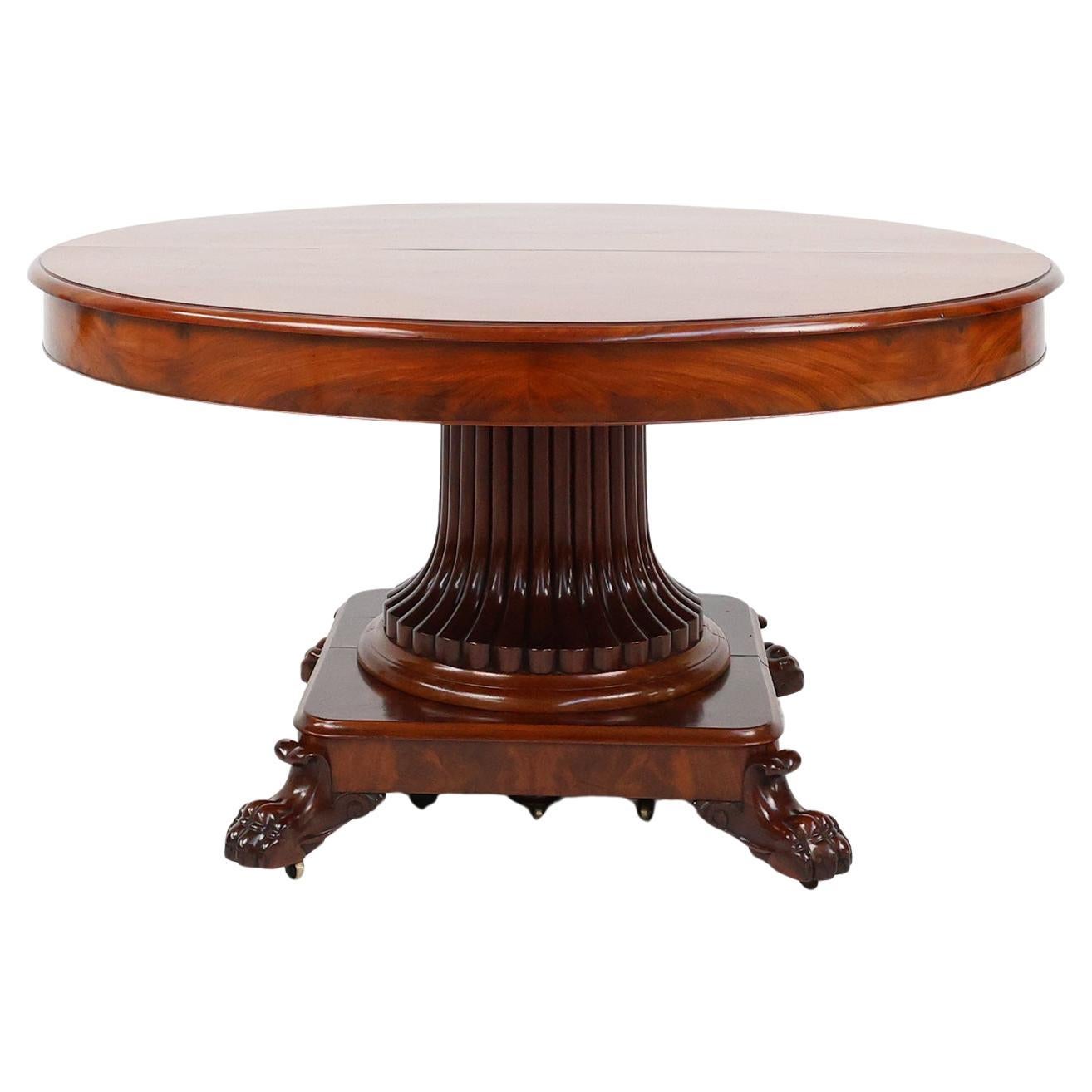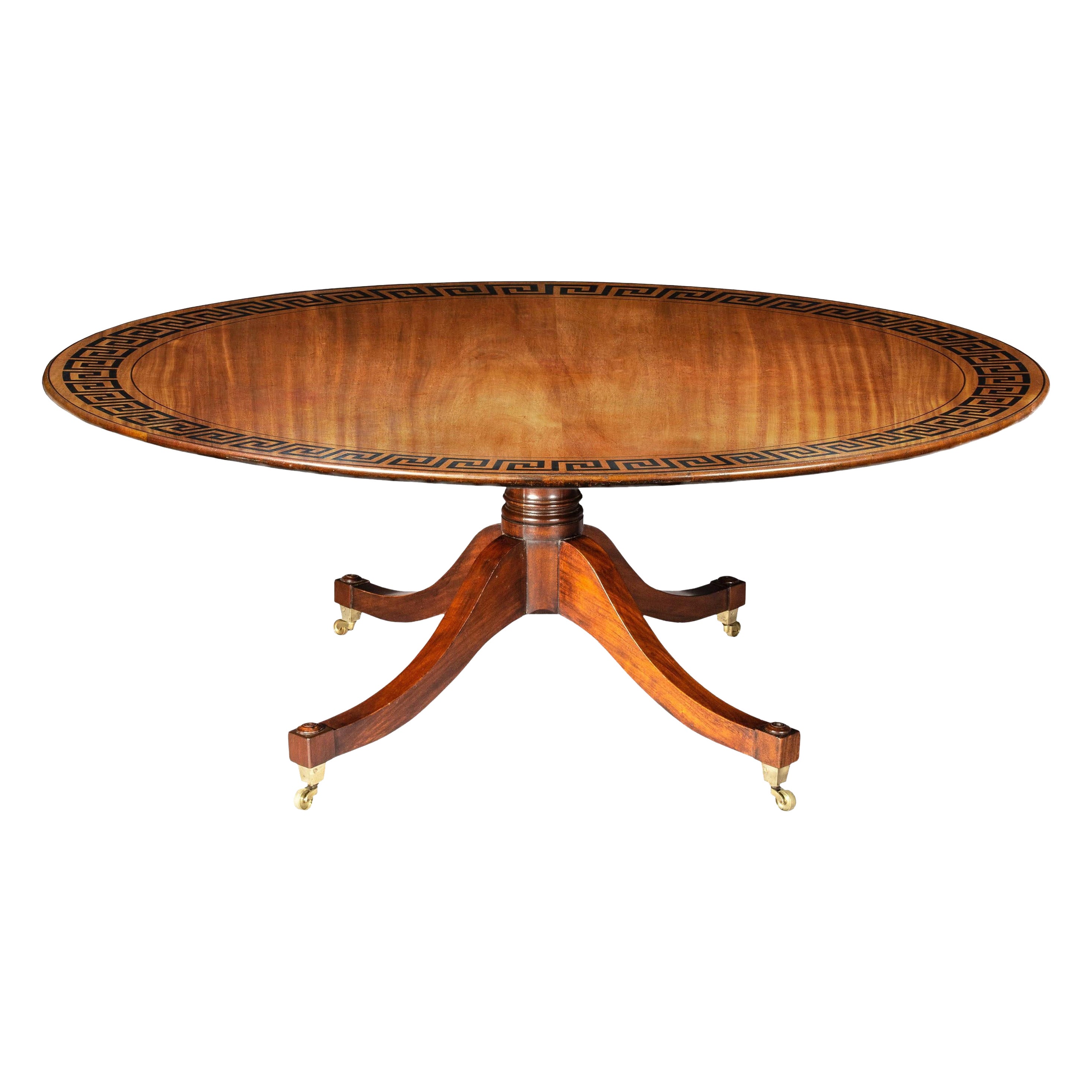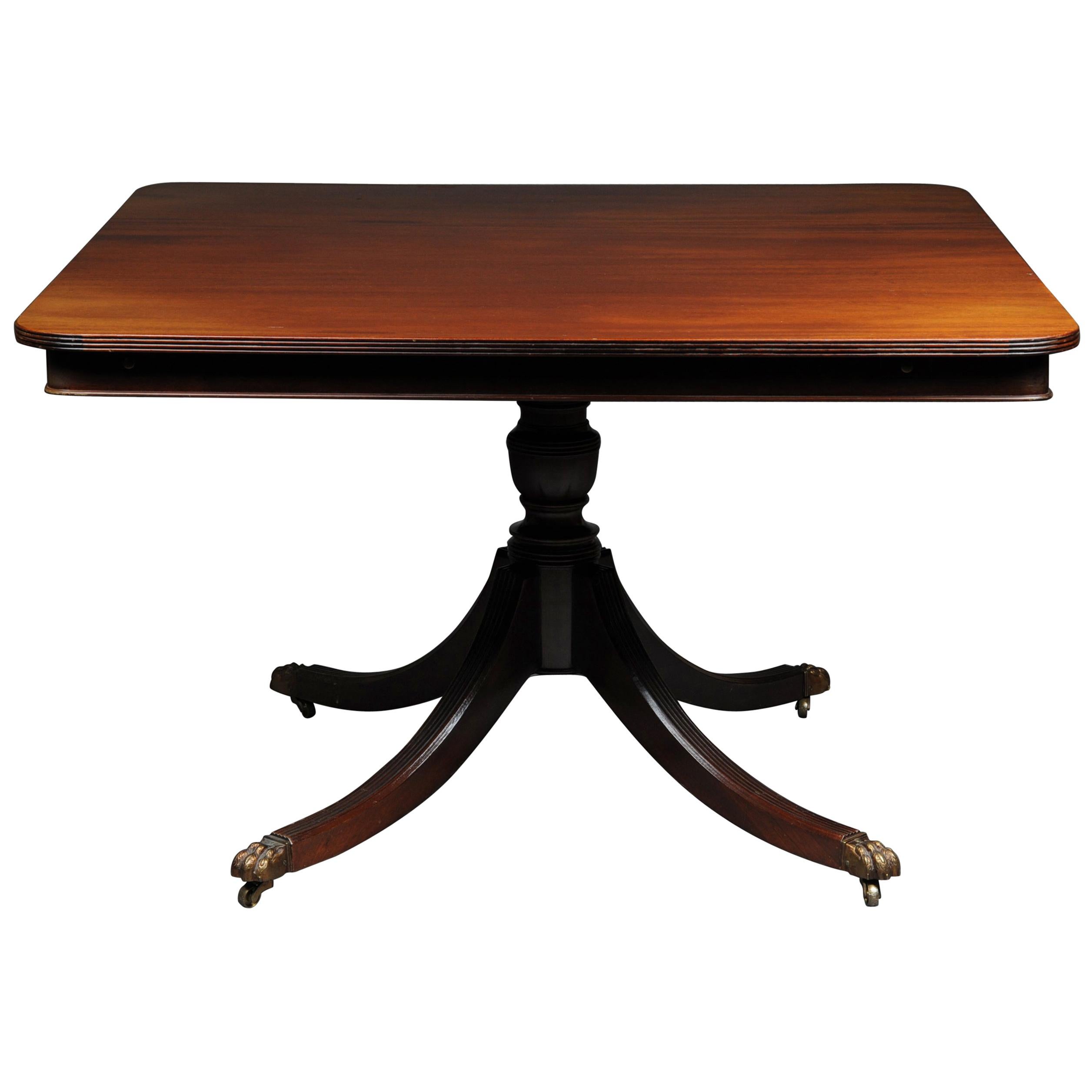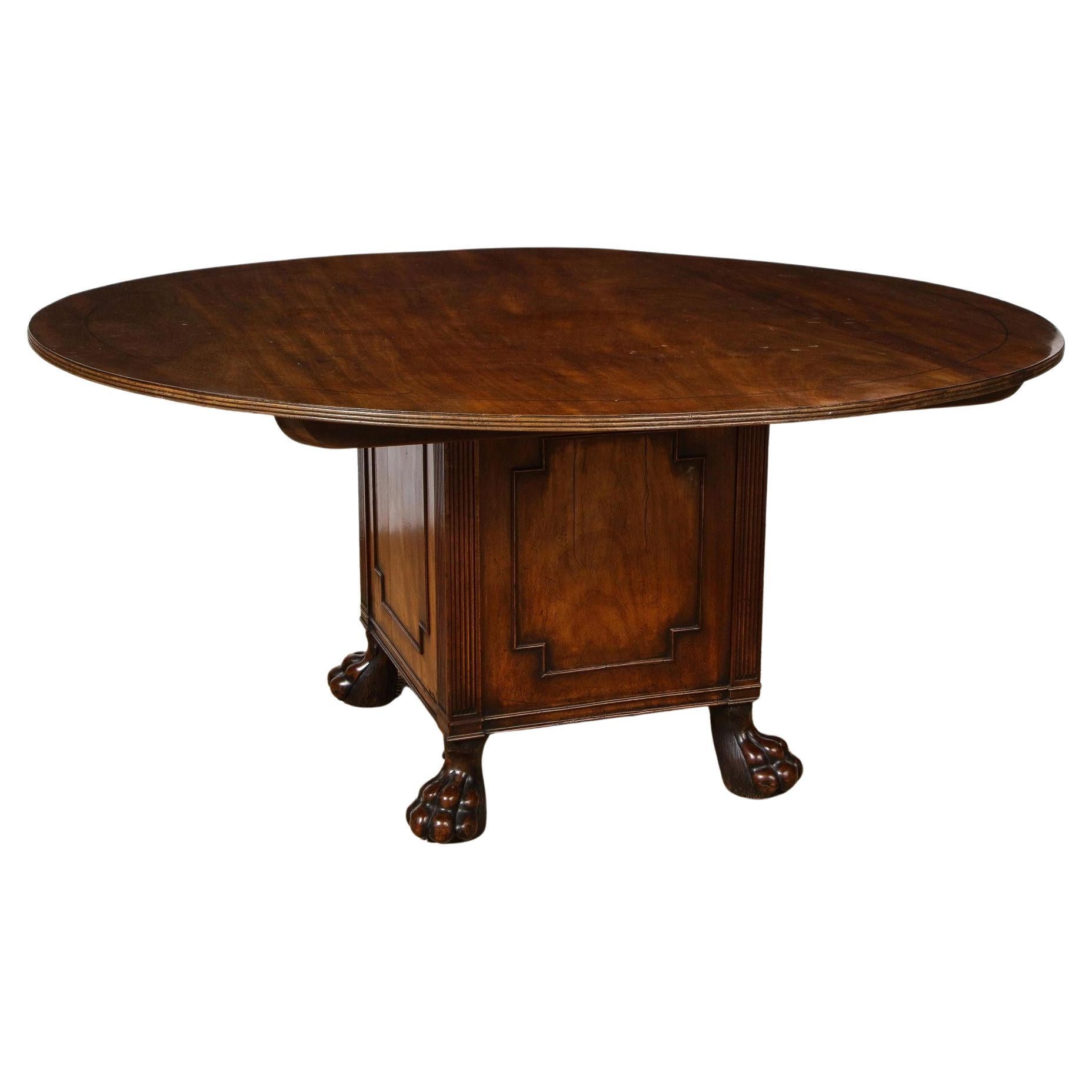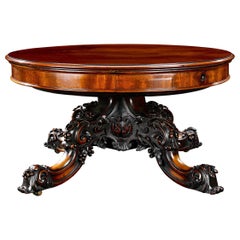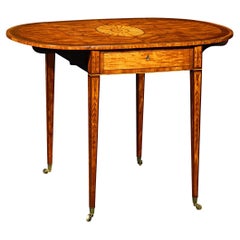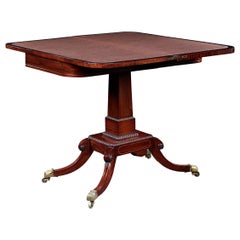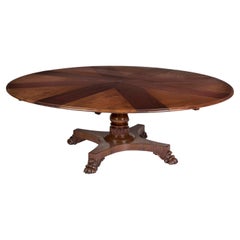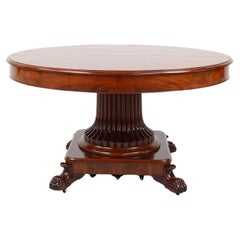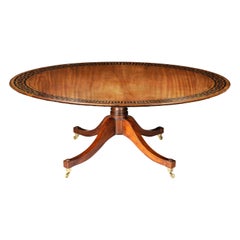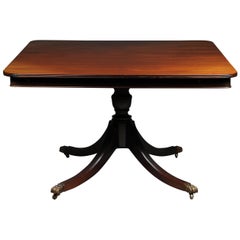Items Similar to Expanding Jupe Dining Table by Johnstone and Jeanes
Video Loading
Want more images or videos?
Request additional images or videos from the seller
1 of 7
Expanding Jupe Dining Table by Johnstone and Jeanes
$288,500
£221,171.86
€253,082.79
CA$407,715.50
A$443,170.62
CHF 237,236.35
MX$5,356,905.50
NOK 2,989,640.48
SEK 2,757,224.86
DKK 1,890,124.17
About the Item
This exceptionally rare circular expanding dining table was designed by Robert Jupe and crafted by the English cabinetmakers Johnstone & Jeanes, successors to Johnstone, Jupe & Co. One of only a handful known from the firm, this table illustrates the Victorian era's quest to combine technical innovation with superb and beautiful craftsmanship. Complete with its original leaves, the table’s circular top is formed from eight separate segments. When the top is rotated, an ingenious swivel mechanism causes the sections to diverge, allowing a set of small or large leaves to be inserted for an adjustable increase in size.
The design for the table was patented by Robert Jupe in 1835, who had envisioned “an improved expanding table so constructed that the sections composing its surface may be caused to diverge from a common center and that the spaces caused thereby may be filled up by inserting leaves or filling pieces.” The first of these fascinating tables were created between 1835 and 1840 during his partnership with John Johnstone and their firm of Johnstone, Jupe & Co. in London. Jupe left the company in 1840, after which the firm changed its name due to a new partnership and became Johnstone & Jeanes. The firm would eventually achieve international fame for its remarkable designs, exhibiting a "circular table made on the expanding principle" like this one at the Great Exhibition of 1851.
Jupe was not alone in his fascination with combining the technical merits of engineering and mechanics with the more artful pursuit of cabinet making. The first half of the 19th century saw a prolific increase in the popularity of applying new ideas to furniture principles, which allowed furniture to serve many purposes. The resulting “patent” furniture was practical and refined, although none so much as this remarkable and quite stunning table which is equally suited for intimate gatherings or large, formal dinners.
Features brass Johnstone & Jeanes plaque
Circa 1850
Measures: 65" diameter x 29 3/4" high
93" diameter when fully expanded
Click here to view a video of this item.
- Creator:Robert Jupe (Designer)
- Dimensions:Height: 29.75 in (75.57 cm)Diameter: 93 in (236.22 cm)
- Style:Victorian (Of the Period)
- Materials and Techniques:
- Place of Origin:
- Period:
- Date of Manufacture:circa 1850
- Condition:General maint. and upkeep expected for an item of this age.
- Seller Location:New Orleans, LA
- Reference Number:Seller: 31-28871stDibs: LU891125629332
About the Seller
5.0
Recognized Seller
These prestigious sellers are industry leaders and represent the highest echelon for item quality and design.
Established in 1912
1stDibs seller since 2010
114 sales on 1stDibs
Typical response time: 4 hours
- ShippingRetrieving quote...Shipping from: New Orleans, LA
- Return Policy
More From This Seller
View All19th Century Exhibition Model of Expanding Table by Samuel Hawkins
By Samuel Hawkins
Located in New Orleans, LA
A masterpiece of both cabinetmaking and mechanical engineering, this one-of-a-kind expanding table was crafted by the renowned cabinetmaker Samuel Hawkins of London for the Great Exhibition of 1851. Diminutive in size, the fascinating table was designed as a model to demonstrate Hawkins’ innovative patent screw movement to visitors of the Exhibition – six million people in total over five months. It was exhibited again a century later at the Victoria & Albert Museum during the Festival of Britain, an event intended “to symbolise two main qualities of the national character: realism and strength on the one hand, and, on the other, independence and imagination” (Catalogue of the Exhibition, 1951, p.117). To this day, the miniature masterpiece demonstrates the quest of English furniture makers to combine technical innovation with superb craftsmanship.
Displaying exceptional ingenuity, Hawkins’ wind-out screw mechanism allowed one to extend the table’s base to accommodate concentric leaves with the simple crank of a handle. It is based on the inventive expanding table originally designed by Robert Jupe in 1835, which used a swivel mechanism to separate sections of the tabletop and allow for segmented leaves to be inserted. Hawkins’ tabletop, on the other hand, extends outwards directly from the center in order to accommodate additional leaves around its diameter. This unique design allowed the mechanism to also smoothly operate on rectangular tables, which could be wound out from the middle to allow for more table space.
Hawkins was not alone in his endeavor to combine the technical merits of engineering and mechanics with the most artful pursuit of cabinetmaking. The first half of the 19th century saw a prolific increase in the popularity of applying new ideas to traditional furniture principles, which allowed furniture to serve many purposes. The resulting “patent” furniture was practical and refined, though few were as innovative as Hawkins’ prodigious design.
Carved with the year of the Exhibition on the beautifully designed pedestal base, the table is a testament to the significance of this innovation. The model is mentioned in detail in the catalog of the Great Exhibition of 1851, the first international exhibition of industry, manufacturing, and science. Held at London’s dazzling Crystal Palace, its visitors were treated to exhibits from around the globe, including feats of engineering, innovations in industry, and marvels of design. Queen Victoria herself was a frequent visitor, along with her husband, Prince Albert, and others including Charlotte...
Category
Antique 19th Century English Other Tables
Materials
Mahogany
George III Pembroke Table attributed to Ince & Mayhew
By Ince & Mayhew
Located in New Orleans, LA
This extraordinary George III-period Pembroke table by London cabinetmakers Ince & Mayhew displays the understated sophistication of the late Georgian era. The surface of the table — including both the central panel and the signature Pembroke hinged flaps — is beautifully detailed with satinwood marquetry, inlaid with a fan medallion and foliate motifs executed with the greatest precision and craftsmanship. The table is set upon slender, tapering legs. The design is indicative of the rising influence of and interest in Neoclassical patterns, favoring motifs from nature or Classical antiquity over the extravagance of the Rococo style.
William Ince and John Mayhew joined their skills as furniture designers and cabinetmakers, opening a firm together on Broad Street in 1759. Over the next forty years, the duo would execute many commissions, and develop a volume of engraved designs entitled The Universal System...
Category
Antique 18th Century English Georgian Drop-leaf and Pembroke Tables
Materials
Satinwood
Victorian Rosewood Table
Located in New Orleans, LA
Rosewood Table
Circa 1890
This exquisite Victorian table is crafted from luxurious rosewood, a highly prized material known for its rich grain and warm hues. The elegantly carved tr...
Category
Antique 19th Century Victorian End Tables
Materials
Rosewood
$6,850
Regency-Era Card Table
Located in New Orleans, LA
This ingenious late Regency card table was designed with both beauty and entertainment in mind. When not in use, its folded D-shaped top sits against the wall providing an elegant si...
Category
Antique Early 19th Century English Regency Game Tables
Materials
Wood
$8,850
19th Century Rosewood and Pietra Paesina Specimen Table Attributed
By Gillows of Lancaster & London
Located in New Orleans, LA
Pietra Paesina is one of the most scarce and wondrous stones on earth, and the surface of this exceptional early 19th-century center table is inset with...
Category
Antique Early 19th Century English Regency Center Tables
Materials
Marble
Specimen Table Attributed to William Trotter
By William Trotter
Located in New Orleans, LA
Octagonal Specimen Table
William Trotter
Early 19th Century
This extraordinary early 19th-century Scottish specimen table is a museum-quality masterpiece attributed to William Trott...
Category
Antique Early 19th Century Scottish Regency Side Tables
Materials
Agate
You May Also Like
Rare & Early Jupe Expanding Dining Table by Johnstone & Jeanes
By Johnstone, Jeanes & Co.
Located in London, GB
A Rare 'Jupe's' Extensible Mechanical Action Circular Dining Table
By Johnstone & Jeanes of New Bond Street
Together with its original Leaf Cabinet
By Johnstone & Jeanes
Constructe...
Category
Antique 19th Century English Dining Room Tables
Materials
Mahogany
Extendable Antique English Dining Table in Victorian style, ca. 1830
Located in Meulebeke, BE
UK / 1830 / dining table / wood / Antique / English / Victorian
Beautiful extendable molded and carved wooden dining table. Crafted in the UK around 1830 in Victorian style. This ta...
Category
Antique Early 19th Century British Victorian Dining Room Tables
Materials
Wood, Mahogany
Large Regency Style Dining Table, Sits 8–10 People
Located in Richmond, London
A generous Regency-style circular dining or center table, ready for placement and immediate use, seating 8–10 people comfortably. Designed to capture both presence and poise, the tab...
Category
20th Century English Regency Revival Dining Room Tables
Materials
Wood
English Dining Table / Table, Mahogany, Victorian, Extendible
Located in Berlin, DE
English dining table / table, mahogany, Victorian - extendible
Victorian table made of solid mahogany, England, 20th century
2 table tops available (see pictures).
Tabletop on four ...
Category
Early 20th Century English Dining Room Tables
Materials
Mahogany
Rare Early 19th century Regency Dining Table
By George Smith
Located in Greenwich, CT
Rare early 19th century Regency center/dining table with cabinet pedestal base in the manner of George Smith and Thomas Hope, the top with ribbed edge over square cupboard base with ...
Category
Antique Early 19th Century English Dining Room Tables
Materials
Mahogany
Important Regency Period Library Table Made After Designs by Thomas Hope
By Thomas Hope
Located in Lymington, Hampshire
An Important Regency Period Library Table Made After Designs by Thomas Hope and Identical to a Pair of Tables at Beechwood Park and Another Potentially From Malahide in Ireland
A Regency oak drum...
Category
Antique 1810s English Regency Center Tables
Materials
Oak
More Ways To Browse
Expandable Mahogany Table
Expanding Dining Tables Antique
Jupe Table
Johnstone Jeanes
Jupe Dining Table
Johnstone And Jeanes
Antique Jupe Table
Taj Mahal Table
Antique Cherry Wood Dining Table
Baker Round Dining Room Table
Brutalist Dining Table Base
Cabriole Leg Extension Dining Table
French Provincial Dining Table And Chairs
Olive Ash Burl
Rectangular Pedestal Tables
Red Travertine Dining Table
Regency Extending Dining Table
Rosewood Black Dining Table
